 |
| Click on image to enlarge. |
It was a perfect end to the day, a typical Florida summer evening when the humidity in the stifling air clings to every inch of your being. My wife and I stood on a rickety dock, each with a wet glass of chilled wine in hand, enjoying the end of daylight as it sweetly kissed the cypress forest. The waning sun over the smooth water had fallen behind the distant storm clouds that earlier in the day moved violently across the sky.
The wooden dock creaked under our weight as we toasted the sky, water, and trees, and then gave thanks for our safe arrival to our temporary home on Lake Rousseau. This soon-to-be ritual of clinking our glasses together at the end of a travel day marked the beginning of our road adventure. After several hours sitting in a full ton truck that pulls our 12,000-lb home, and white-knuckling the steering wheel, I recorded the mileage in our travel ledger, the first entry of hundreds. Without mercy, constant torrential rain and a break-a-way switch mishap introduced us to the challenges of RV traveling. So it was with great relief that our first campsite greeted us as the skies cleared and the steam rose from the saturated ground.
After settling in, I barely had enough time to pour a glass of celebratory wine and watch the final minutes of glistening light on the water as the cypress trees came to life from dusk’s gentle illumination. To me, the scene unfolding was a touch of Old Florida revealing itself through a cluttered history of ambitious commercial development. Could there possibly be a photo opportunity here?
Lake Rousseau is a man-made one, created by the damming of the Withlacootchee River over a hundred years ago. Later, a lock was built to accommodate boat traffic through what was to become the Cross Florida Barge Canal. For various reasons the canal never reached completion. Much of the land and water were eventually turned over to the state and Lake Rousseau became a popular fishing destination.
A narrow inlet with small privately-owned docks separated me
from the wall of lovely cypress trees. The reflections
of the old docks and trees with draping Spanish moss were fully
realized in the flat water. Normally, anything man made is avoided in my
images, but one of the docks near the opening of the inlet caught my eye. The watery forest with its dark and mysterious inner sanctum surrounded the
dock, reminding me of an “Authentic Florida” scene from a Marjorie Kinnan Rawlings
novel.
The skull and cross bone flag hanging
on the edge of the dock was a perfect focal point for this scene. The blue and
white flag contrasted against the natural green tones, and the red ring buoy
added a nice touch of color. A vertical composition worked well to emphasize the height of the trees and to avoid other man -made objects. The
rule of thirds was followed for the prominent focal point, while the cypress tree
branches above the dock were emphasized to add depth.
In a setting like this one, isolation is key to a good
composition, and this is where a long lens is most useful. A 225mm focal length
isolated the dock giving the scene a timelessness. For all we know, it is a
dark, mysterious place deep within a Florida swamp, a perfect hideaway for a
pirate. Who would know it is on a popular man-made lake?
With a touch of Old Florida and only 250 miles under our
RV-travel belt, my first photograph on the road was taken.
“Where to next?” she asked.




Yay! I get to be first to post a comment. Looking forward to learning more about your extraordinary photography skills! -Spencer
ReplyDeleteSpencer, if you are the only one reading my blogs, then I am happy and content!
ReplyDelete